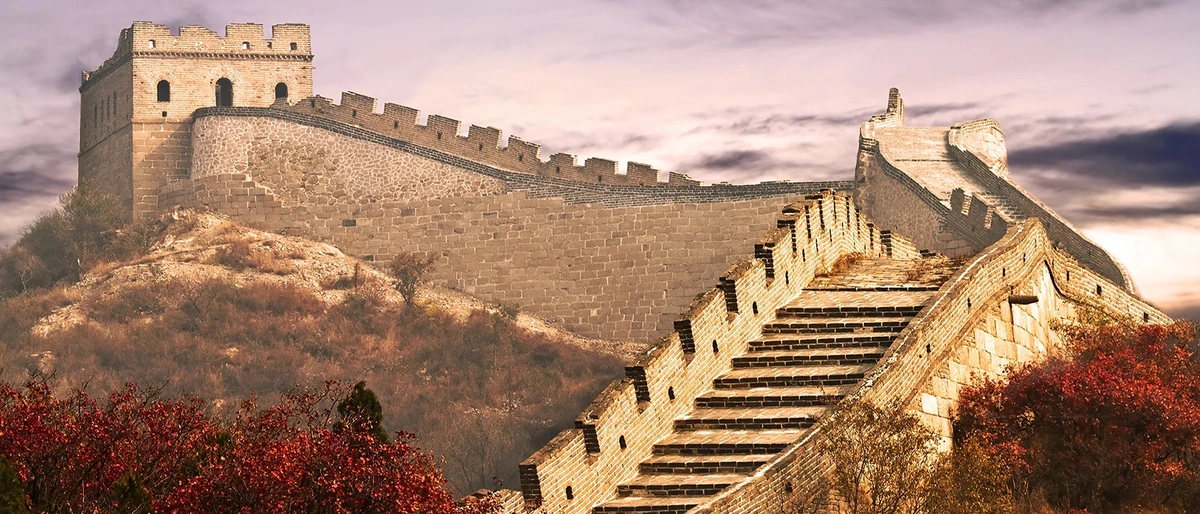Built to stop invaders from the north, China’s Great Wall is a monumental feat of man, rivaling any other structure every conceived. It passes over mountains, plateaus and deserts in the northeast of the country for thousands of miles and can be visited by tourists.
The Great Wall was first started in the 7th century BC and went across 4,000 miles from the east coast to Xinjiang in the northwest at its longest length in the 17th century. It is on average 18 feet wide and 25 feet high, while the strategically positioned watchtowers add further depth.
Today you can visit stretches of the Great Wall in Liaoning, Hebei, Shanxi, Shaanxi, Ningxia, and Gansu, to Inner Mongolia and just outside Beijing. The latter is one of the easiest spots to visit although is also the most touristed. Today there are around 100 sections that go from well maintained to seriously dilapidated, plus there are also yet-to-be-discovered sections.
The building of the wall sped up movements of soldiers exponentially and was also used as a means of communication and warning. It was originally known as the Ten Thousand Li Wall, with a li being about a third of a mile.
What is it? A barrier and elevated roadway to transport troops and keep out invading Mongols.
When to go? May or October have less rain, heat, cold and visitors.
Nearest town: Beijing
Don’t miss: the Badaling and Juyongguan sections that are near to Beijing. Be sure to visit them early in the day.
Trivia: it is thought by archaeologists that sections of the Great Wall remain buried and await excavation.
Getting there
The best spot to visit the wall for those with little time is to fly to Beijing, take a bus to the city and a tour from there. The airport is 20-odd miles to the northeast of the city along the Jichang Expressway and tours can be organized from major hotels and agencies.
Built to stop invaders from the north, China’s Great Wall is a monumental feat of man, rivaling any other structure every conceived. It passes over mountains, plateaus and deserts in the northeast of the country for thousands of miles and can be visited by tourists.
Introduction
The Great Wall was first started in the 7th century BC and went across 4,000 miles from the east coast to Xinjiang in the northwest at its longest length in the 17th century. It is on average 18 feet wide and 25 feet high, while the strategically positioned watchtowers add further depth.
Today you can visit stretches of the Great Wall in Liaoning, Hebei, Shanxi, Shaanxi, Ningxia, and Gansu, to Inner Mongolia and just outside Beijing. The latter is one of the easiest spots to visit although is also the most touristed. Today there are around 100 sections that go from well maintained to seriously dilapidated, plus there are also yet-to-be-discovered sections.
The building of the wall sped up movements of soldiers exponentially and was also used as a means of communication and warning. It was originally known as the Ten Thousand Li Wall, with a li being about a third of a mile.
What is it? A barrier and elevated roadway to transport troops and keep out invading Mongols.
When to go? May or October have less rain, heat, cold and visitors.
Nearest town: Beijing
Don’t miss: the Badaling and Juyongguan sections that are near to Beijing. Be sure to visit them early in the day.
Trivia: it is thought by archaeologists that sections of the Great Wall remain buried and await excavation.
Getting there
The best spot to visit the wall for those with little time is to fly to Beijing, take a bus to the city and a tour from there. The airport is 20-odd miles to the northeast of the city along the Jichang Expressway and tours can be organized from major hotels and agencies.
